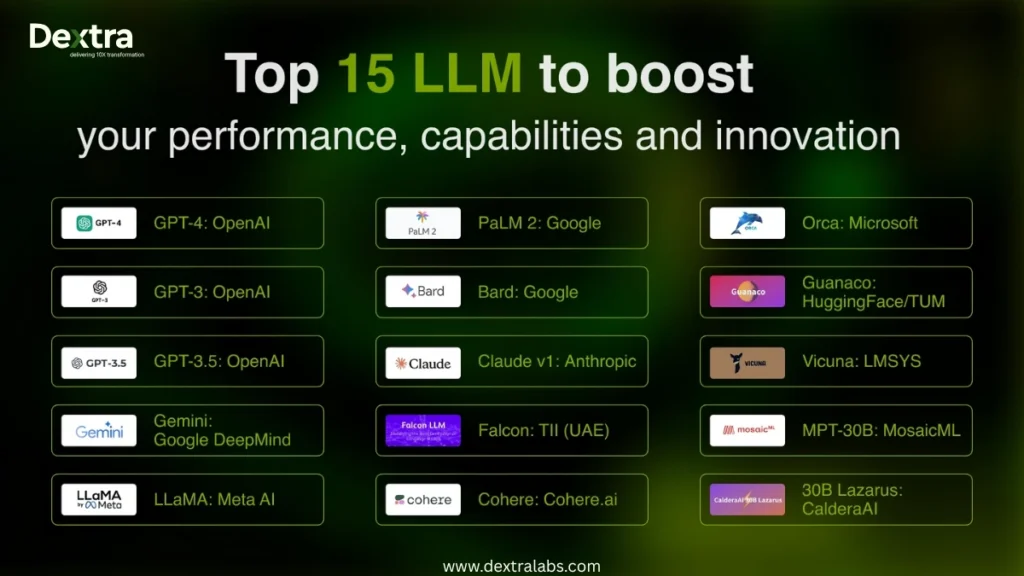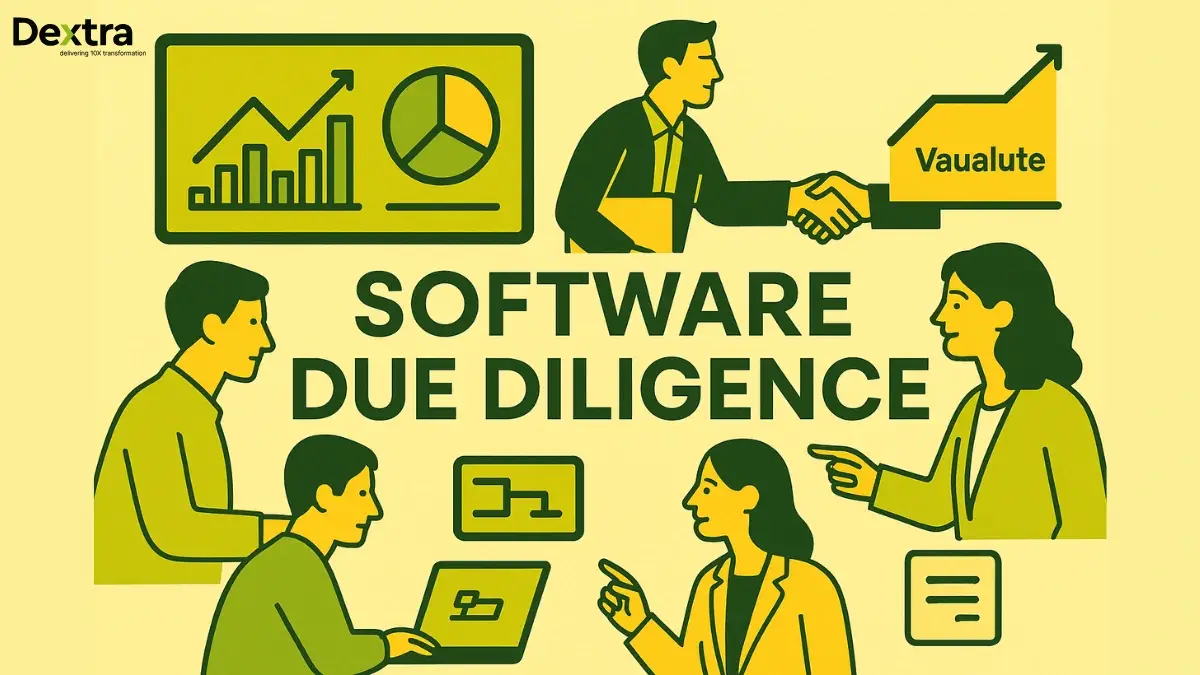Still wondering which is the Best LLM models to trust in 2025? You’re not alone.
As generative AI takes the world by storm, businesses and developers are scrambling to find the right large language model (LLM) that can actually deliver. The problem? The LLM landscape is evolving fast. From closed-source giants to open-source challengers, the options are exploding—and so is the market.
Just look at the numbers: the global LLM market is expected to surge from USD 5.03 billion in 2025 to USD 13.52 billion by 2029, growing at a jaw-dropping 28% CAGR. And last year alone, this domain clocked an annual growth rate of 100.4%, according to Discovery Platform’s latest data. According to our study, North America, already leading the charge with 32.1% of global revenue, is projected to reach a staggering USD 105.5 billion by 2030.
But amidst all this growth, a bigger challenge looms, what are the best llm models, how to choose the right model. GPT? Claude? Gemini? Or perhaps one of the rising open-source stars?
That’s where this guide by Dextralabs steps in.
We’ve done the research, tested the performance, and curated the 15 best LLMs in 2025—so you don’t have to. Whether you’re building the next-gen AI product or integrating smarter tools into your workflow, this list will help you find a model that’s powerful, scalable, and future-ready.
Let’s dive in and explore the models shaping the future of generative AI.
Here are the Top 15 LLMs in 2025 that are leading the industry in performance, capabilities, and innovation:
| Model | Developer | Params | Multimodal | Open Source | Highlight |
| GPT-4 | OpenAI | Undisclosed | Yes | No | Best factual reasoning |
| GPT-3 | OpenAI | 175B | No | No | Foundational GPT architecture |
| GPT-3.5 | OpenAI | N/A | No | No | RLHF fine-tuned |
| Gemini | Google DeepMind | N/A | Yes | No | Highest MMLU score |
| LLaMA | Meta AI | 7B–65B | No | Yes | Open-source benchmark leader |
| PaLM 2 | ~540B | No | No | Best multilingual model | |
| Bard | ~1.6T | Yes | No | Real-time internet access | |
| Claude v1 | Anthropic | N/A | No | No | 100K context window |
| Falcon | TII (UAE) | Up to 40B | No | Yes | Best open-source overall |
| Cohere | Cohere.ai | 6B–52B | No | No | Enterprise custom LLM |
| Orca | Microsoft | 13B | No | No | Lightweight GPT-4 competitor |
| Guanaco | HuggingFace/TUM | 7B–65B | No | Yes | High open-source benchmark scores |
| Vicuna | LMSYS | 33B | No | Yes | Cost-efficient GPT alternative |
| MPT-30B | MosaicML | 30B | Yes | Yes | Multimodal and Apache licensed |
| 30B Lazarus | CalderaAI | 30B | No | Yes | High text generation performance |
1. GPT‑ 4 (OpenAI)
GPT – 4, released by OpenAI in March 2023, is the epitome of contemporary LLMs. Though its parameter count is not publicly confirmed, it is a massive improvement over its predecessors with outstanding reasoning, coding, and academic capabilities. GPT-4 added multimodal inputs (image and text), which suited it for more versatile applications. With better alignment, reduced hallucinations, and human feedback training (RLHF), GPT-4 sets the gold standard for factuality and reliability in AI.
Key Features of GPT 4:
- Accepts both text and image inputs for versatile interactions
- Achieves top scores in factual and reasoning benchmarks
- Trained with Reinforcement Learning from Human Feedback (RLHF)
- Robust performance across complex domains like law, medicine, and coding
2. GPT-3 by OpenAI
Launched in 2020, GPT-3 was a revolutionary creation in Natural Language Processing (NLP), with 175 billion parameters and the biggest of its generation. Developed through a decoder-only transformer architecture, GPT-3 was able to produce human-like text for multiple tasks such as sentence completion, article composition, and Q&A. Its launch was a huge improvement over its earlier variant, GPT-2, which was 10 times smaller. In 2022, Microsoft acquired exclusive rights to license GPT-3’s base model.
Key Features of GPT-3:
- Unmatched Scale: 175B parameters delivering high-quality language generation.
- Zero-Shot Learning: Can handle tasks without specific training examples.
- Deep Contextual Understanding: Maintains coherence over long text spans.
3. GPT-3.5 by OpenAI
A newer model of GPT-3, GPT-3.5 was trained with Reinforcement Learning from Human Feedback (RLHF). It drives the free ChatGPT version and is recognized for responding quickly. GPT-3.5 achieved a score of 48.1% on the HumanEval benchmark, giving a decent performance in programming and reasoning tasks, but it is still capable of hallucinating facts.
Key Features of GPT 3.5:
- Performance Boosts: Improved accuracy and speed over GPT-3.
- Quick Response Time: Highly responsive and ideal for casual use. It’s one of the Best LLM models for chatbot.
- Fine-Tuning Friendly: Easier to adapt for task-specific needs.
4. Gemini by Google DeepMind
Launched in December 2023, Gemini was designed as a native multimodal model, capable of understanding and generating text, images, video, code, and audio. Gemini Ultra, the most advanced version, became the first model to outperform human experts on the MMLU benchmark with a 90% score. Developers can access Gemini Pro via Google AI Studio or Google Cloud’s Vertex AI.
Key Features of Gemini:
- Multimodal Abilities: Seamlessly integrates text, images, audio, and video.
- Context-Aware Conversations: Maintains dialogue coherence and nuance.
- State-of-the-Art Reasoning: Tops academic benchmarks across disciplines.
5. LLaMA by Meta AI
Meta’s LLaMA (Large Language Model Meta AI) was released in early 2023, with a range of open-source models from 7B to 65B parameters. It has surpassed GPT-3 in some benchmarks and enjoys significant popularity among the developer and research communities because it is open to use and modify.
Key Features of LLaMA:
- Open-Source Advantage: Supports innovation and community-driven fine-tuning.
- Advanced Reasoning: Handles complex logic and inference tasks well, these features make it one of the best LLM AI.
- Extended Context Memory: Maintains understanding over long dialogues.
6. PaLM 2 (Bison-001) by Google
PaLM 2, trained on 540 billion parameters, is superior in logic, programming, mathematics, and understanding multiple languages. It can answer riddles, decipher idioms, and pick up subtle cues of language in over 20 languages. Interesting enough, it provides quick responses and normally gives three choices simultaneously.
Key Features of PaLM 2:
- Pattern Recognition: Learns and impales sophisticated linguistic patterns.
- Adaptive Learning: Improves continuously from usage data.
- Multilingual Proficiency: Fluent in large amounts of languages and dialects.
7. Bard by Google (Powered by LaMDA)
Bard is Google’s experimental conversational AI built on LaMDA (Language Model for Dialogue Applications). It stands out for being internet-connected, meaning it can fetch real-time information unlike many Large Language Models trained on static data. Bard also boasts a colossal 1.6 trillion parameter model, offering high performance in understanding nuanced language.
Key Features of Bard Ai:
- Real-Time Knowledge Access: Connected to the web for current info.
- Massive Scale: Designed to handle large and complex queries.
- User-Centric Dialogue: Built specifically for smooth human conversation which made it one of the best llm models 2024.
8. Claude v1 by Anthropic
Developed by Anthropic (a company founded by ex-OpenAI researchers), Claude v1 is a lesser-known but highly capable LLM. It stands out with a massive 100,000-token context window enabling it to process entire books or large documents. It scored 75.6 on the MMLU benchmark and 7.94 on MT-Bench, making it a strong contender to GPT-4.
Key Features of Claude v1:
- Huge Context Window: Supports input of ~75,000 words at once.
- Deep Language Understanding: Handles complex and nuanced inputs with ease.
- Flexible Task Handling: Performs well across diverse NLP tasks and workflows.
9. Falcon
Developed by the Technology Innovation Institute (TII), UAE, Falcon is a causal decoder-only, best llm models open source known for its efficiency, scalability, and top-tier performance. It outperforms other open-source models like LLaMA, StableLM, and MPT. Trained using AWS SageMaker on a large corpus of curated web text, Falcon benefits from custom tooling and a specialized data pipeline to ensure data quality. It employs rotary positional embeddings and multi-query attention for enhanced performance and supports multiple languages, primarily English, German, Spanish, and French.
Key Features of Falcons Ai:
- Efficiency & Scalability: Designed for large-scale deployments with minimal resource overhead.
- Optimized for NLP Tasks: Excels in text classification, language generation, and sentiment analysis.
- Model Compression: Uses techniques to reduce memory and computation without performance loss.
10. Cohere
Founded by former Google Brain engineers, Cohere Ai offers enterprise-grade LLMs that are customizable for business-specific applications. Models range from 6B to 52B parameters. The Cohere Command model is particularly praised for its accuracy and robustness, leading benchmarks like Stanford HELM. Cohere powers AI for companies like Spotify, Jasper, and HyperWrite. However, its cost $15 per million tokens is relatively high.
Key Features of Cohere Ai:
- Contextual Intelligence: Understands nuanced relationships and textual dependencies.
- Conversational AI Focus: Enhances user interaction by detecting intents and context shifts.
- Multi-Turn Dialogue Handling: Maintains coherent, ongoing conversations over multiple exchanges which make it one of the best llm models for RAG.
11. Orca
Built by Microsoft, Orca is a compact yet powerful model with 13 billion parameters, designed to match the performance of models 10x its size. It’s a fine-tuned version of LLaMA 2 and employs Prompt Erasure and teacher-student training methods using synthetic datasets. Orca ai performs comparably to GPT-3.5 and even GPT-4 in some tasks.
Key Features of orca ai:
- Multimodal Capabilities: Supports text, image, and audio input for a richer understanding.
- Cross-Modal Learning: Understands and relates data across different formats.
- Context Sensitivity: Adapts well to cues in complex multimodal conversations.
12. Guanaco
Guanaco is an open-source chatbot model family derived from LLaMA, ranging from 7B to 65B parameters. The Guanaco-65B model ranks just below Falcon in performance among open-source models, scoring 52.7 on MMLU. Trained on the OASST1 dataset using the QLoRA technique, it provides excellent task performance while conserving memory.
Key Features of guanaco llm model
- Unsupervised Learning: Learns from unlabeled data, generating relevant responses.
- Semantic Mastery: Understands implicit meaning and intent which make it one of the best LLM models for chatbot.
- Adaptive Learning: Continually improves through self-supervised techniques.
13. Vicuna
Developed by LMSYS, Vicuna is a LLaMA-based open-source model trained on 70,000 user-shared ChatGPT conversations from ShareGPT. Trained efficiently (in just one day for $300), vicuna ai offers 33 billion parameters and scores 7.12 in MT-Bench, making it a high-performing model on a budget.
Key Features of vicuna ai:
- Efficient Training: Achieves high performance with minimal compute resources.
- Robust NLP Abilities: Supports summarization, generation, and understanding tasks make it one of the Best LLM AI.
- Adaptable & Scalable: Easily deployed in various use cases, from research to production.
14. MPT-30B
A commercial, open-source LLM released under Apache 2.0, MPT-30B llm model stands out for surpassing GPT-3 and competing closely with Falcon-40B and LLaMA-30B. It has a context length of 8,000 tokens and scores 6.39 on MT-Bench. It has been fine-tuned on datasets such as GPTeacher, Baize, and Guanaco.
Key Features of MPT-30B:
- Multimodal Understanding: Handles text, audio, and image inputs effectively.
- Cross-Modal Knowledge Transfer: Learns relationships across modalities.
- Contextual Depth: Captures subtle context shifts with high accuracy.
15. 30B Lazarus
Launched in 2023 by CalderaAI, 30B Lazarus is a fine-tuned evolution of the LLaMA model using LoRA techniques. Scoring 81.7 on HellaSwag and 45.2 on MMLU, it stands among the best llm models open source for text-generation, though it’s not optimized for chat-based tasks.
Key Features of 30B Lazarus:
- Highly Scalable: Suitable for large data and diverse operational environments.
- Continual Learning: Adapts over time without retraining from scratch makes it one of the best LLM models.
- Resistant to Concept Drift: Maintains accuracy even with shifting data trends.
Conclusion
Choosing the right Large Language Model (LLM) in 2025 comes down to what you truly need—whether it’s reliable factual answers, multilingual support, real-time internet access, or a powerful open-source option you can build on. Models like GPT-4, Gemini, and LLaMA stand out not just for their technical strengths but for how effectively they solve real problems.
If you’ve been wondering what are the best LLM models, this list offers a clear starting point. Each model brings something different to the table, and the best choice depends on your goals, team, and use case.
At Dextralabs, we work closely with businesses to help them get the most out of these advanced models. From setting up LLMs to fine-tuning prompts and integrating them into daily operations, we make the process smooth and practical. If you’re looking to take the next step with LLMs, Dextralabs is here to guide you with real solutions that work.
FAQs on best LLMs:
Q. Which is the most powerful LLM model?
OpenAI’s GPT-4o (Omni) is widely considered the most powerful general-purpose LLM in 2025. It combines text, vision, and audio processing in real time and exhibits top-tier reasoning, coding, and instruction-following abilities. Right now, it’s one of the best llm models in the world.
Q. Which is the best LLM leaderboard?
The most recognized and actively updated LLM leaderboards include:
– Chatbot Arena (lmsys.org) – Uses Elo ratings from real user comparisons.
– Hugging Face Open LLM Leaderboard – Ranks open-source models using standardized benchmarks like MMLU, ARC, and HellaSwag.
– HELM (Holistic Evaluation of Language Models) – Provides detailed task-wise evaluations and social impact metrics.
Q. Which LLM is best in 2025?
That depends on the use case, but overall:
– GPT-4o (OpenAI) – Best all-rounder for general use and coding.
– Gemini 1.5 Pro (Google DeepMind) – Strong in multimodal tasks and memory retention.
– Claude 3 Opus (Anthropic) – Excellent for long-context tasks, safety alignment, and reasoning.
– Mistral Large / Mixtral – Best open-source models as of mid-2025.
– Command R+ (by Cohere) – Best for llm models for RAG-based applications (retrieval-augmented generation).
Q. Which LLM is best for which task?
As of 2025, GPT-4o and Claude 3 Opus are best for general-purpose reasoning tasks. For coding, GPT-4o and Gemini 1.5 Pro lead the pack with advanced code understanding and generation. If you’re working with long documents, Claude 3 Opus and Gemini 1.5 Flash handle extended context exceptionally well. For real-time multimodal input (text, voice, image), GPT-4o is the top choice. In open-source RAG (Retrieval-Augmented Generation) workflows, Command R+ and Mistral Large perform reliably. For instruction following, GPT-4o and Claude 3 Sonnet give consistent, precise outputs. And if you need lightweight, on-device models, Phi-3 Mini and Gemma 2 are your go-to options.
Q. Which LLM is the most advanced today?
GPT-4o is the most advanced LLM available to the public. It integrates real-time audio, vision, and text processing into a single model with exceptional fluency, memory, and responsiveness.
Q. What is the largest open LLM model?
As of 2025:
– Falcon 180B (by TII, UAE) is still the largest publicly released open-source LLM with 180 billion parameters.
– Yi-34B, Mixtral (Mixture of Experts), and Mistral Large are among the most performant open models, despite smaller sizes, thanks to efficient training and architecture.








